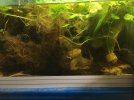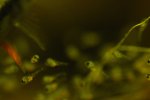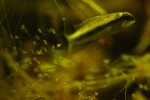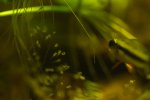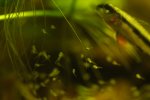- Messages
- 181
- Location
- Germany, Kassel
Hi,
After years of unsuccessful eggs from several pairs of Dicrossus filamentosus, this last batch of eggs managed to hatch. I suppose using distilled instead of RO water or using peat moss and alder cones instead of catappa leaves did the trick. But after 2-3 days of their hatching, most of the fry died (not suddenly, slowly in a day or two). I don't know if they are all dead right now but when I just tried to siphon some out, the 3 I did managed to siphon were dead. Female is still agressively protecting the dead fry against the siphon hose.
Since the female laid eggs, I didn't do any water changes. When I saw the wrigglers I removed the male. I kept feeding the female every day, but less than I normally do when she doesn't have offspring.
Does anything I did sound wrong? Maybe I should've kept doing water changes? If yes, then how much and how often? Or maybe feeding the female caused water pollution? I really doubt the cause is just the inexperience of the female, because she did not eat the fry alive, the fry are definitely dying before she eats or removes them. I guess she could be hurting them as she moves them from one spot to another in her mouth, but I don't know if that is a realistic scenario.
After years of unsuccessful eggs from several pairs of Dicrossus filamentosus, this last batch of eggs managed to hatch. I suppose using distilled instead of RO water or using peat moss and alder cones instead of catappa leaves did the trick. But after 2-3 days of their hatching, most of the fry died (not suddenly, slowly in a day or two). I don't know if they are all dead right now but when I just tried to siphon some out, the 3 I did managed to siphon were dead. Female is still agressively protecting the dead fry against the siphon hose.
Since the female laid eggs, I didn't do any water changes. When I saw the wrigglers I removed the male. I kept feeding the female every day, but less than I normally do when she doesn't have offspring.
Does anything I did sound wrong? Maybe I should've kept doing water changes? If yes, then how much and how often? Or maybe feeding the female caused water pollution? I really doubt the cause is just the inexperience of the female, because she did not eat the fry alive, the fry are definitely dying before she eats or removes them. I guess she could be hurting them as she moves them from one spot to another in her mouth, but I don't know if that is a realistic scenario.
